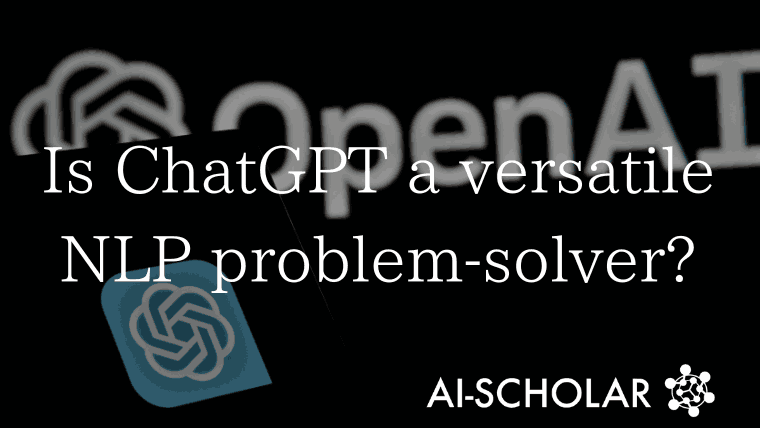
What Tasks Cannot Be Handled By ChatGPT?
3 main points
✔️ ChatGPT was shown to be a strong general-purpose model for a variety of natural language processing tasks, especially excelling in inference and dialogue tasks.
✔️ It was noted that there are still challenges in certain tasks (e.g., sequence tagging) and that it is not perfect.
✔️ ChatGPT is an evolving general-purpose language processing tool that has the potential to improve its reasoning and dialogue capabilities in future research.
Is ChatGPT a General-Purpose Natural Language Processing Task Solver?
written by Chengwei Qin, Aston Zhang, Zhuosheng Zhang, Jiaao Chen, Michihiro Yasunaga, Diyi Yang
(Submitted on 8 Feb 2023 (v1), revised 15 Feb 2023 (this version, v2), latest version 19 Nov 2023 (v3))
Comments: Published on arxiv.
Subjects: Computation and Language (cs.CL); Artificial Intelligence (cs.AI)
code:

The images used in this article are from the paper, the introductory slides, or were created based on them.
Summary
This paper shows that ChatGPT, a large language model, can perform a variety of natural language processing tasks on data it sees for the first time. Specifically, it was noted that ChatGPT 2 can generate superior replies to human input and automatically correct previous errors. However, it is still uncertain how versatile a model ChatGPT is. In this study, we evaluate ChatGPT on 20 popular natural language processing datasets and analyze its zero-shot learning ability.
Results indicate that while ChatGPT performs well on many tasks, it still has challenges with certain tasks. For example, it is reported to perform well on tasks related to reasoning, such as arithmetic reasoning, but struggles with certain tasks, such as sequence tagging. The paper further provides analysis through specific case studies.
Introduction
This paper is a study of a large language model, ChatGPT, which has been shown to be able to handle a novel task, called zero-shot learning, as well as the ability to answer appropriate questions. However, it is noted that the current model is not yet perfect and that challenges remain in certain tasks.
ChatGPT is trained using reinforcement learning and is capable of generating high-quality responses to human input. However, compared to other models, it may perform poorly on certain tasks. For example, it performs well in inference tasks such as arithmetic reasoning, but faces challenges in common sense logical reasoning and certain tasks (e.g., array tagging).
In short, ChatGPT can perform a certain amount of generic tasks, but it is not yet considered a fully generic language model. Researchers will investigate ChatGPT's performance and limitations in detail, with the goal of finding clues for future improvements.
Related Research
This study focuses on ChatGPT's zero-shot learning capabilities, specifically investigating its performance on inference and classical natural language processing tasks. It also provides background on three areas of research: large-scale language models (LLMs), zero-shot learning, and thought-chain prompts.
For large-scale language models (LLMs), the latest research has developed models with huge parameter counts, which have been shown to perform strongly on complex tasks. Not only model size and training methods, but also supervisory learning and human feedback contribute to performance improvement.
Zero-shot learning is a technique in which models learn to tackle new tasks without the use of labeled training examples. Modern language models have successfully done this, and ChatGPT is one example. This study investigates how well ChatGPT performs in zero-shot learning.
With respect to the thought chain prompts, a method is introduced to induce the model to generate intermediate inference steps. It is suggested that this may allow models to perform better when tackling more complex tasks. Recent research has focused on ways to incorporate visual features and improve manual CoTs.
Overall, this study provides new insights into ChatGPT's language processing capabilities and explores advances in large-scale language modeling and zero-shot learning.
Methodology
This section describes a method used to compare the zero-shot learning performance of ChatGPT and GPT-3.5. Basically, we are looking at how well the models learn for a given task instruction and test problem on a variety of tasks.
Although ChatGPT and GPT-3.5 share the same basic GPT (Generative Pre-trained Transformer) architecture, some important differences should be supplemented.
- Design Purpose
ChatGPT is a model focused on interactive tasks. It is fine-tuned to be suitable for user interaction and designed to facilitate contextual understanding.
GPT-3.5 is a model focused on more general language generation tasks. It is designed for a wide range of tasks, including not only dialogue, but also sentence generation and question answering. - Training Data
ChatGPT is fine-tuned based on a dialogue dataset. This data helps to learn the characteristics of user interaction.
GPT-3.5 is trained using a general natural language dataset (e.g., a large web corpus). It is based on general knowledge rather than dialogue. - Performance and Intended Use
ChatGPT is primarily suited for interactive tasks such as dialogue and question answering. It allows for natural interaction with users.
GPT-3.5 is suitable for a wider range of tasks and can be used for a wide variety of natural language processing tasks, such as sentence generation, sentence summarization, sentence translation, and question answering.
In short, ChatGPT is specialized for dialogue, while GPT-3.5 is for general language generation tasks. Which one to use depends on the nature and purpose of the task.
Specifically, it is stated that given a task instruction (P) and a test question (X), the model (f) is expected to produce a target text (Y) based on it. For example, in the case of an emotion analysis task, the model is instructed to label the given text as positive or negative and is expected to output an accurate emotion.
In addition to this, a two-stage prompting technique is introduced. In the first stage, a "think step-by-step" instruction is employed, while in the second stage, a new input (P1) is given to derive the final answer using self-generated rationale (R). This allows for more complex tasks.
Finally, it is emphasized that each time a new query is created, the conversation in ChatGPT is cleared to avoid the influence of previous samples.
Experiment
The paper describes experiments investigating how well ChatGPT and GPT-3.5 perform on a variety of tasks, using 20 different datasets, each corresponding to a different task. Specific tasks include inference, natural language reasoning, question answering, dialogue, summarization, unique expression recognition, and sentiment analysis.
Within these datasets, there are four categories of reasoning tasks: arithmetic reasoning, common sense reasoning, symbolic reasoning, and logical reasoning, and the information for each dataset is summarized in Table 1. The experiment will compare how well ChatGPT and GPT-3.5 perform on these tasks.

Tables and figures showing the accuracy of different models without and with CoT (chain of thoughts) are also provided. Through the results of these experiments, the performance of ChatGPT and GPT-3.5 is compared to various popular techniques and model variants to assess which is superior.
Result
Experiments evaluating the performance of ChatGPT and GPT-3.5 showed that ChatGPT outperformed GPT-3.5 in some cases and underperformed it in others for different types of natural language processing tasks.
For arithmetic reasoning, ChatGPT outperformed GPT-3.5, showing strong arithmetic reasoning performance, especially on the data set without CoT (chain of thoughts). On the other hand, ChatGPT performed worse than GPT-3.5 on common sense reasoning tasks, suggesting that this may be due to model size scaling and lack of background knowledge.
In natural language inference, ChatGPT outperformed GPT-3.5 in the zero-shot setting, demonstrating superior ability to infer sentence relationships. In the question-answering task, ChatGPT also outperformed GPT-3.5, demonstrating its ability to prioritize inference functions.
In dialogue, ChatGPT significantly outperformed GPT-3.5, indicating that it could reason more effectively about a given context without adding irrelevant information. However, for the summary task, ChatGPT underperformed GPT-3.5, which was attributed to the lack of control over the length of the output.
In the sentiment analysis, ChatGPT performed less well than GPT-3.5, especially in the positive data, where there was a performance imbalance. These results suggest that ChatGPT excels on certain tasks while leaving room for improvement on others.
ChatGPT and fine-tuning a full set or a small number of shots

In Table 12, a performance comparison is made between ChatGPT and the previous fine-tuning methods. In most cases, ChatGPT performs worse than the previous fine-tuning methods, indicating that ChatGPT is not yet a perfect general-purpose language processing tool. This means that it does not excel in all tasks, suggesting that there is room for improvement.
Conclusion
In this study, we took on a variety of natural language processing tasks to test ChatGPT's capabilities, and while ChatGPT was shown to be a strong general-purpose model for a wide variety of tasks, it still has challenges with certain tasks. For example, while it excels in inference and dialogue tasks, it struggles with specific challenges such as sequence tagging.
In conclusion, ChatGPT is an evolving general-purpose language processing tool, and future research may further improve its reasoning and interaction capabilities. However, it is not yet perfect, suggesting that it has limitations in certain tasks. This is an indication for future research and a clue to the potential range of applications for ChatGPT.
Personally, I believe that while ChatGPT is powerful in everyday language understanding and interaction, it should be understood that there is room for improvement in certain issues. Let's keep an eye on the evolution of ChatGPT in the future.
Categories related to this article




![[JMMLU] Prompt Polit](https://aisholar.s3.ap-northeast-1.amazonaws.com/media/July2024/jmmlu-520x300.png)



